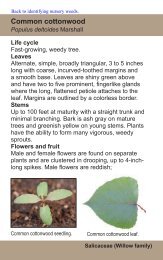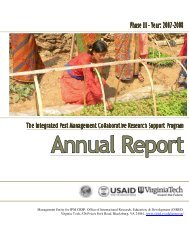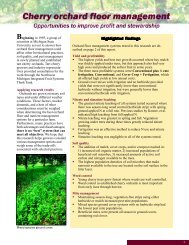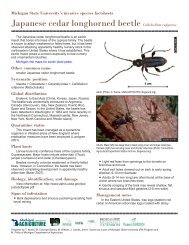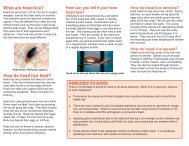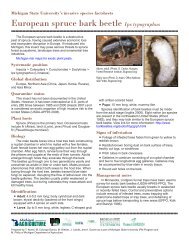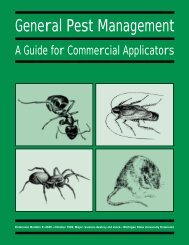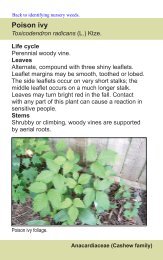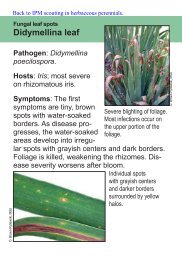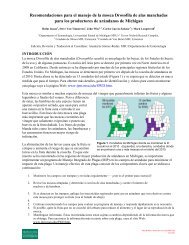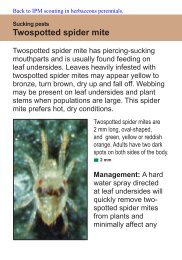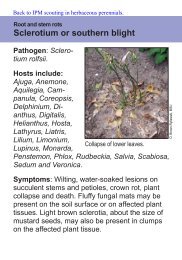Whole Manual - Michigan State University: Integrated Pest ...
Whole Manual - Michigan State University: Integrated Pest ...
Whole Manual - Michigan State University: Integrated Pest ...
Create successful ePaper yourself
Turn your PDF publications into a flip-book with our unique Google optimized e-Paper software.
MESOTHORAX—The second segment of an insect’s<br />
thorax. One pair of legs and usually one pair of wings are<br />
attached.<br />
METAMORPHOSIS—A change in the shape, or form, of<br />
an animal. Usually used when referring to insect development.<br />
METATHORAX—The third segment of an insect’s thorax.<br />
One pair of legs and often one pair of wings are attached.<br />
MICROBIAL DEGRADATION—Breakdown of a chemical<br />
by microorganisms.<br />
MICROBIAL PESTICIDE—Bacteria, viruses, fungi, and<br />
other microorganisms used to control pests. Also called<br />
biorationals.<br />
MICROORGANISM—An organism so small it can be<br />
seen only with the aid of a microscope.<br />
MITICIDE—A pesticide used to control mites. (See<br />
acaricide.)<br />
MODE OF ACTION—The way in which a pesticide<br />
exerts a toxic effect on the target plant or animal.<br />
MOLLUSCICIDE—A chemical used to control snails<br />
and slugs.<br />
MOLT—Periodic shedding of the outer layer (e.g., an<br />
insect’s exoskeleton is shed periodically).<br />
MONITORING—On-going surveillance. Monitoring<br />
includes inspection and record keeping. Monitoring<br />
records allows technicians to evaluate pest population<br />
suppression, identify infested or non-infested sites, and<br />
manage the progress of the management or control program.<br />
MYCELIUM—A mass of hyphae; has a fuzzy appearance.<br />
NECROSIS—Death of plant or animal tissues that<br />
results in the formation of discolored, sunken, or necrotic<br />
(dead) areas.<br />
NEMATODE—A small, slender, colorless roundworm;<br />
nematodes live in soil and water or as parasites of plants<br />
or animals.<br />
NEMATICIDE—A chemical used to control nematodes.<br />
NON-INFECTIOUS DISEASE—Disease caused by nonliving<br />
agents such as drought, soil compaction, temperature<br />
or moisture extremes, nutrient deficiency, etc.; cannot<br />
reproduce and spread.<br />
NON-POINT SOURCE POLLUTION—Pollution from a<br />
generalized area or weather event.<br />
NON-RESIDUAL PESTICIDE—<strong>Pest</strong>icides applied to<br />
obtain effects only during the time of treatment.<br />
NON-TARGET ORGANISM—Any plant or animal<br />
other than the intended target(s) of a pesticide application.<br />
NOZZLE FLOW RATE—The amount of material that<br />
passes through the nozzle for a specific amount of time;<br />
dependent on pressure and tip size.<br />
NYMPH—The developmental stage of insects with gradual<br />
metamorphosis that hatches from the egg. Nymphs<br />
become adults.<br />
ORAL TOXICITY—The ability of a pesticide to cause<br />
injury or acute illness when taken by mouth. One of the<br />
common exposure routes.<br />
ORDER—See taxonomy.<br />
ORGANOPHOSPHATES—A large group of pesticides<br />
that contain the element phosphorus and inhibit<br />
cholinesterase in animals.<br />
PARASITE—A plant, animal, or microorganism living<br />
in, on, or with another living organism for the purpose of<br />
obtaining all or part of its food.<br />
PARASITOID—An organism that lives during its development<br />
in or on the body of a single host organism, eventually<br />
killing it.<br />
PATHOGEN—A disease-causing organism.<br />
PERENNIAL—A plant that lives for more than two<br />
years.<br />
PERSONAL PROTECTIVE EQUIPMENT (PPE)—<br />
Devices and clothing intended to protect a person from<br />
exposure to pesticides. Includes such items as long-sleeved<br />
shirts, long trousers, coveralls, suitable hats, gloves, shoes,<br />
respirators, and other safety items as needed.<br />
PEST—An undesirable organism (plant, animal, bacterium,<br />
etc.); any organism that competes with people for<br />
food, feed, or fiber, causes structural damage, is a public<br />
health concern, reduces aesthetic qualities, or impedes<br />
industrial or recreational activities.<br />
PESTICIDE—A chemical or other agent used to kill,<br />
repel, or otherwise control pests or to protect from a pest.<br />
PETIOLE—The stalk of a leaf.<br />
pH—A measure of the acidity/alkalinity of a liquid—<br />
acid below pH7; basic or alkaline above pH7 (up to 14).<br />
PHEROMONE—A substance emitted by an animal to<br />
influence the behavior of other animals of the same<br />
species. Examples are sex pheromones (to attract mates)<br />
and aggregation pheromones (to keep members of the<br />
same species together in a group). Some pheromones are<br />
synthetically produced for use in insect traps.<br />
PHOTODEGRADATION—Breakdown of chemicals by<br />
the action of light.<br />
PHYSICAL CONTROL—Habitat alteration or changing<br />
the infested physical structure—e.g., caulking holes, sealing<br />
cracks, tightening around doors and windows, moisture<br />
reduction, ventilation, etc.<br />
PHYTOTOXICITY—Injury to plants caused by a chemical<br />
or other agent.<br />
POINT OF RUNOFF—The point at which a spray starts<br />
to run or drip from the surface to which it is applied.<br />
POINT SOURCE POLLUTION—Pollution from a specific<br />
source.<br />
Appendix C<br />
96<br />
Vegetable Crop <strong>Pest</strong> Management



